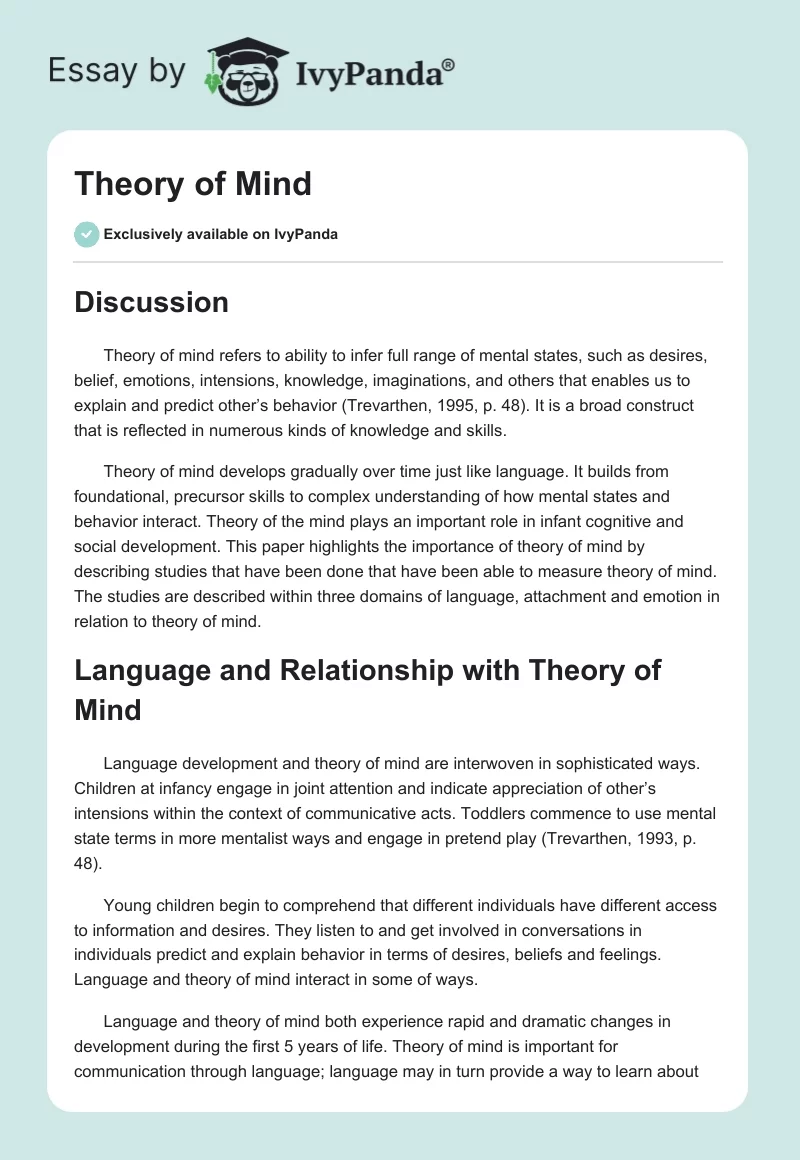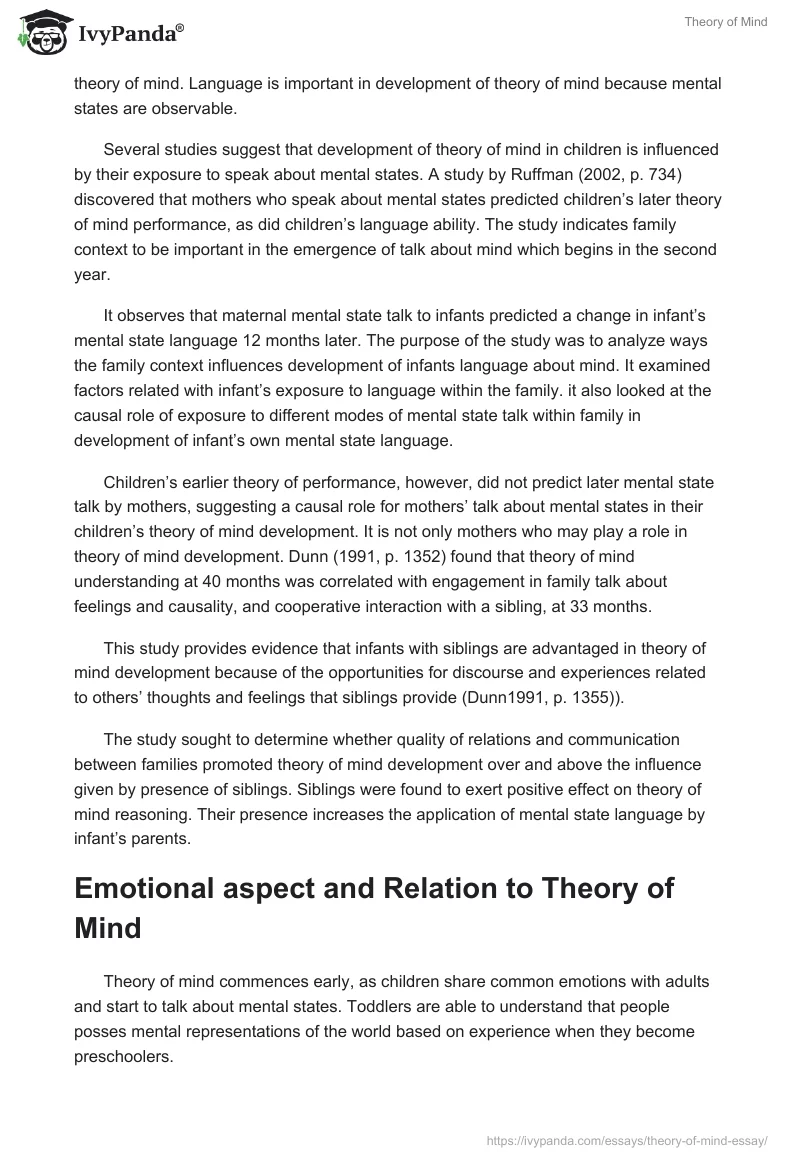Discussion
Theory of mind refers to ability to infer full range of mental states, such as desires, belief, emotions, intensions, knowledge, imaginations, and others that enables us to explain and predict other’s behavior (Trevarthen, 1995, p. 48). It is a broad construct that is reflected in numerous kinds of knowledge and skills.
Theory of mind develops gradually over time just like language. It builds from foundational, precursor skills to complex understanding of how mental states and behavior interact. Theory of the mind plays an important role in infant cognitive and social development. This paper highlights the importance of theory of mind by describing studies that have been done that have been able to measure theory of mind. The studies are described within three domains of language, attachment and emotion in relation to theory of mind.
Language and Relationship with Theory of Mind
Language development and theory of mind are interwoven in sophisticated ways. Children at infancy engage in joint attention and indicate appreciation of other’s intensions within the context of communicative acts. Toddlers commence to use mental state terms in more mentalist ways and engage in pretend play (Trevarthen, 1993, p. 48).
Young children begin to comprehend that different individuals have different access to information and desires. They listen to and get involved in conversations in individuals predict and explain behavior in terms of desires, beliefs and feelings. Language and theory of mind interact in some of ways.
Language and theory of mind both experience rapid and dramatic changes in development during the first 5 years of life. Theory of mind is important for communication through language; language may in turn provide a way to learn about theory of mind. Language is important in development of theory of mind because mental states are observable.
Several studies suggest that development of theory of mind in children is influenced by their exposure to speak about mental states. A study by Ruffman (2002, p. 734) discovered that mothers who speak about mental states predicted children’s later theory of mind performance, as did children’s language ability. The study indicates family context to be important in the emergence of talk about mind which begins in the second year.
It observes that maternal mental state talk to infants predicted a change in infant’s mental state language 12 months later. The purpose of the study was to analyze ways the family context influences development of infants language about mind. It examined factors related with infant’s exposure to language within the family. it also looked at the causal role of exposure to different modes of mental state talk within family in development of infant’s own mental state language.
Children’s earlier theory of performance, however, did not predict later mental state talk by mothers, suggesting a causal role for mothers’ talk about mental states in their children’s theory of mind development. It is not only mothers who may play a role in theory of mind development. Dunn (1991, p. 1352) found that theory of mind understanding at 40 months was correlated with engagement in family talk about feelings and causality, and cooperative interaction with a sibling, at 33 months.
This study provides evidence that infants with siblings are advantaged in theory of mind development because of the opportunities for discourse and experiences related to others’ thoughts and feelings that siblings provide (Dunn1991, p. 1355)).
The study sought to determine whether quality of relations and communication between families promoted theory of mind development over and above the influence given by presence of siblings. Siblings were found to exert positive effect on theory of mind reasoning. Their presence increases the application of mental state language by infant’s parents.
Emotional aspect and Relation to Theory of Mind
Theory of mind commences early, as children share common emotions with adults and start to talk about mental states. Toddlers are able to understand that people posses mental representations of the world based on experience when they become preschoolers.
They understand that these representations may be lies, and that behavior is driven by these representations in concert with these changes in theory of mind. The theory of mind assists forms the foundation of communication that involves rewarding exchange of ideas, feelings and information.
Social and emotional development has significant implications for infants developing awareness of self, and their knowledge of mental states of others. According to Trevarthen (1995, p. 227), studies by Legerstee show that development of theory of mind is gradual process for a child. It is a function that develops upon the infants preexisting ability to distinguish between people and objects. Infants identify with other humans and imitate their actions right from birth.
This is because they understand other people just like themselves. Legerstee posits that infants construct knowledge of self and others through social exchanges (Trevarthen, 1995, p. 227)). Partially, maternal emotion mirroring is responsible for development of emotional awareness in others and self and for emotion regulation.
Legerstee in study reviews recent studies with babies aged 2-3 months that supports the idea infants imitate people’s actions and not objects simulating these actions. Infants between 2-3 months old are capable of smiling and vocalizing more on responsible people than to interactive objects. However, infants become agitated when people to communicate or act responsibly to their responses, but not when they are objects refrain from responding.
Attachment aspect and Relation to Theory of Mind
Attachment relationships provide children the means by which to attend to and use mental representations of others to guide behavior. It shares similarities to theory of mind whereby children develop theories of individual’s beliefs and desires that account for their behavior.
Theory of mind enables children to use information related to internal states, for instance, individual’s beliefs and desires, to interpret behavior. Therefore, a secure attachment can improve children’s sensitivity to internal states initially within attachment partners and subsequently within others (Trevarthen, 1995, p. 227).
Studies on theory of mind development in typical situations that concentrate on the aspect of interaction indicate close relation between the quality of affective bond between child and care giver and theory of mind development. Positive relationship can be seen between secure attachment and better results in theory of mind tasks (Fonagy, 1997, p.51) considers in his hypothesis that secure attachment facilitates development of understanding of mind in children.
In addition to maturational processes, theory of mind development can influence by social means. The relationship of early care giver with a child can shape the child’s expectations of other’s behavior.
This is because the construction of mental representations of surrounding social world is a natural consequence of early care giver relationship. Theory of mind later development can be influenced externally from the very beginning. Children learn about their social worlds by directly or indirectly listening to adults or aged children conversing events around them (Symons, 2004, p. 4).
Conclusion
As studies suggest, theory of mind is necessary to the social growth and development of children. Theory of mind enables children to interpret the thoughts and beliefs of others. it also enables children to attribute meaning to others behavior. The relationship of aspects of language, emotion, and attachment assists us to learn a number of things. For instance, language and speech pathologists in an effort to assist children become competent in communication would be assisted from consideration of their client’s theory of mind abilities.
Works Cited
Dunn, J., Brown, J., Slomkowski, C., Tesla, C., & Youngblade, L. Young children’s understanding of other people’s feelings and beliefs: Individual differences and their antecedents. Child Development, 1991, 62, 1352–1366.
Fonagy, P., Redfern, S., & Charman, T. The relationship between belief-desire reasoning and a projective measure of attachment security (SAT). British Journal of Developmental Psychology, 1997, 15, 51–61
Ruffman, T., Slade, L., & Crowe, E. The relation between children’s and mothers’ mental state language and theory-of-mind understanding. Child Development, 2002, 73, 734–751.
Symons, D., & Clark, S. A longitudinal study of mother–child relationships and theory of mind in the preschool period. Social Development, 2000, 9, 3–23.
Trevarthen, C. The Function of Emotions in Early Infant Communication and Development. New Perspectives in early Communicative Development, 1993, 48-52.
Woolfe, T., Want, S., & Siegal, M. Signposts to development: Theory of mind in deaf children. Child Development, 2002, 73, 768–778.


